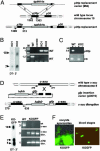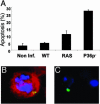Genetically attenuated, P36p-deficient malarial sporozoites induce protective immunity and apoptosis of infected liver cells
- PMID: 16103357
- PMCID: PMC1189305
- DOI: 10.1073/pnas.0500925102
Genetically attenuated, P36p-deficient malarial sporozoites induce protective immunity and apoptosis of infected liver cells
Abstract
Immunization with Plasmodium sporozoites that have been attenuated by gamma-irradiation or specific genetic modification can induce protective immunity against subsequent malaria infection. The mechanism of protection is only known for radiation-attenuated sporozoites, involving cell-mediated and humoral immune responses invoked by infected hepatocytes cells that contain long-lived, partially developed parasites. Here we analyzed sporozoites of Plasmodium berghei that are deficient in P36p (p36p(-)), a member of the P48/45 family of surface proteins. P36p plays no role in the ability of sporozoites to infect and traverse hepatocytes, but p36p(-) sporozoites abort during development within the hepatocyte. Immunization with p36p(-) sporozoites results in a protective immunity against subsequent challenge with infectious wild-type sporozoites, another example of a specifically genetically attenuated sporozoite (GAS) conferring protective immunity. Comparison of biological characteristics of p36p(-) sporozoites with radiation-attenuated sporozoites demonstrates that liver cells infected with p36p(-) sporozoites disappear rapidly as a result of apoptosis of host cells that may potentiate the immune response. Such knowledge of the biological characteristics of GAS and their evoked immune responses are essential for further investigation of the utility of an optimized GAS-based malaria vaccine.
Figures



Similar articles
-
Genetically attenuated P36p-deficient Plasmodium berghei sporozoites confer long-lasting and partial cross-species protection.Int J Parasitol. 2007 Nov;37(13):1511-9. doi: 10.1016/j.ijpara.2007.05.005. Epub 2007 May 21. Int J Parasitol. 2007. PMID: 17604034
-
Protective Efficacy Induced by Genetically Attenuated Mid-to-Late Liver-Stage Arresting Plasmodium berghei Δmrp2 Parasites.Am J Trop Med Hyg. 2016 Aug 3;95(2):378-82. doi: 10.4269/ajtmh.16-0226. Epub 2016 Jun 13. Am J Trop Med Hyg. 2016. PMID: 27296385 Free PMC article.
-
Assessing the adequacy of attenuation of genetically modified malaria parasite vaccine candidates.Vaccine. 2012 Mar 30;30(16):2662-70. doi: 10.1016/j.vaccine.2012.02.010. Epub 2012 Feb 16. Vaccine. 2012. PMID: 22342550
-
Current Challenges in the Identification of Pre-Erythrocytic Malaria Vaccine Candidate Antigens.Front Immunol. 2020 Feb 21;11:190. doi: 10.3389/fimmu.2020.00190. eCollection 2020. Front Immunol. 2020. PMID: 32153565 Free PMC article. Review.
-
Parasite Recognition and Signaling Mechanisms in Innate Immune Responses to Malaria.Front Immunol. 2018 Dec 19;9:3006. doi: 10.3389/fimmu.2018.03006. eCollection 2018. Front Immunol. 2018. PMID: 30619355 Free PMC article. Review.
Cited by
-
Genetically engineered, attenuated whole-cell vaccine approaches for malaria.Hum Vaccin. 2010 Jan;6(1):107-13. doi: 10.4161/hv.6.1.9654. Epub 2010 Jan 29. Hum Vaccin. 2010. PMID: 19838068 Free PMC article. Review.
-
Vaccination with live Plasmodium yoelii blood stage parasites under chloroquine cover induces cross-stage immunity against malaria liver stage.J Immunol. 2008 Dec 15;181(12):8552-8. doi: 10.4049/jimmunol.181.12.8552. J Immunol. 2008. PMID: 19050274 Free PMC article.
-
Targeted deletion of SAP1 abolishes the expression of infectivity factors necessary for successful malaria parasite liver infection.Mol Microbiol. 2008 Jul;69(1):152-63. doi: 10.1111/j.1365-2958.2008.06271.x. Epub 2008 May 5. Mol Microbiol. 2008. PMID: 18466298 Free PMC article.
-
Disruption of plasmepsin-4 and merozoites surface protein-7 genes in Plasmodium berghei induces combined virulence-attenuated phenotype.Sci Rep. 2011;1:39. doi: 10.1038/srep00039. Epub 2011 Jul 18. Sci Rep. 2011. PMID: 22355558 Free PMC article.
-
Role of Plasmodium berghei cGMP-dependent protein kinase in late liver stage development.J Biol Chem. 2010 Jan 29;285(5):3282-8. doi: 10.1074/jbc.M109.070367. Epub 2009 Nov 24. J Biol Chem. 2010. PMID: 19940133 Free PMC article.
References
-
- Frevert, U. (2004) Trends Parasitol. 9, 417-424. - PubMed
-
- Mota, M. M., Hafalla, J. C. & Rodriguez, A. (2001) Science 291, 141-144. - PubMed
-
- Sultan, A. A., Thathy, V., Frevert, U., Robson, K. J., Crisanti, A., Nussenzweig, V., Nussenzweig, R. S. & Menard, R. (1997) Cell 90, 511-522. - PubMed
-
- Menard, R. (2001) Cell Microbiol. 3, 63-73. - PubMed
Publication types
MeSH terms
Substances
Grants and funding
LinkOut - more resources
Full Text Sources
Other Literature Sources
Medical

